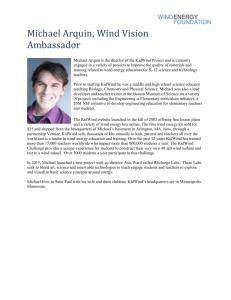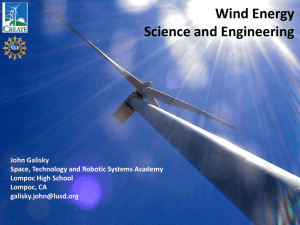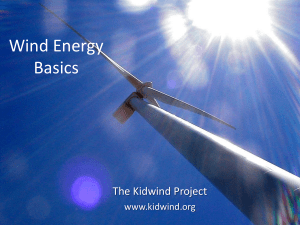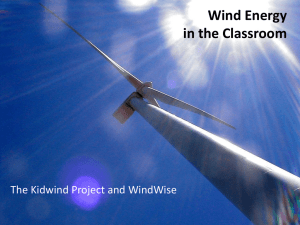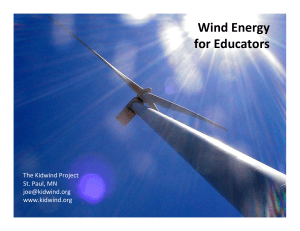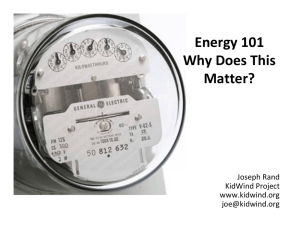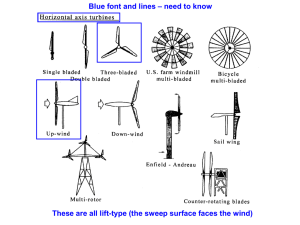Wind 101 - KidWind
advertisement
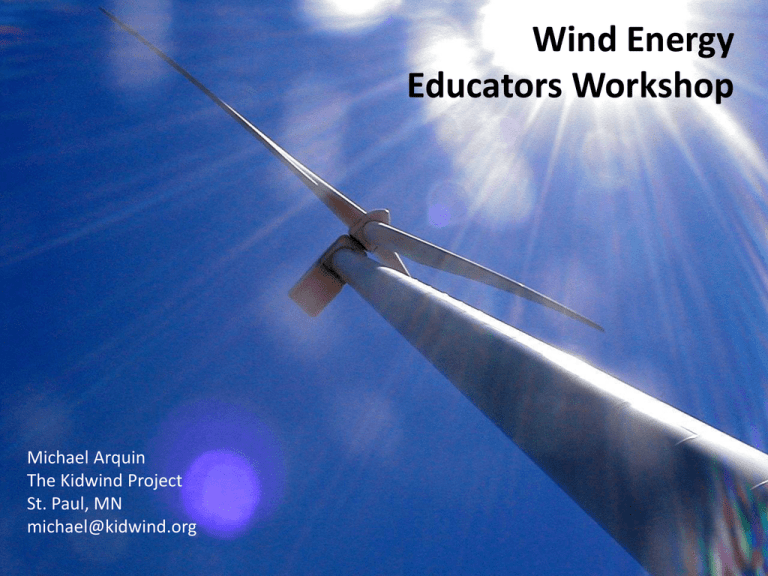
Wind Energy Educators Workshop Michael Arquin The Kidwind Project St. Paul, MN michael@kidwind.org What is KidWind? The KidWind Project is a team of teachers, students, engineers and practitioners exploring the science behind wind energy in classrooms around the US. Our goal is to introduce as many people as possible to the elegance of wind power through hands-on science activities which are challenging, engaging and teach basic science principles. KidWind Project | www.kidwind.org Why Wind Education in K-12 ? • Students learn science/math standards – Lessons are completely scalable from elementary through college level • Addresses myths regarding wind energy – Improves the local understanding of wind energy – Provides a bulwark against misunderstandings and fictional problems with wind energy • Encourages higher interest in Science and Math – Science/Math activities with “larger social purpose” • Students learn about jobs/careers in wind industry, as well as opportunities for further training Expensive Wind Kits… $99 ?? $200 !! $200 ?? $800 !! $300 “Complete Renewable Energy Set” Demonstration – little experimental value Typical Wind Lessons - Not Technical •Beaufort Scale •Pinwheels •Student Reports •Demonstrations •Discussion Activity All very interesting but very little of the science and technology related to the current wind industry is presented. In fact most text books are pretty negative about the future of wind and misrepresent the technology miserably. This is strange because… Wind Energy is the Fastest Growing Energy Source in the World!! US installed capacity grew 45% in 2007 and 50% in 2008!!! KidWind Project | www.kidwind.org KidWind Project | www.kidwind.org 2008: 8,358 megawatts (MW) of new wind energy capacity installed • 50% growth rate! • Brings US total installed wind energy capacity to 25,170 MW • Enough electricity to power the equivalent of close to 7 million households! • 2009 was a slower year due to the economy KidWind Project | www.kidwind.org KidWind Project | www.kidwind.org Why such growth…costs! 1979: 40 cents/kWh 2000: 4-6 cents/kWh • Increased Turbine Size • R&D Advances • Manufacturing Improvements NSP 107 MW Lake Benton wind farm 4 cents/kWh (unsubsidized) 2004: 3 – 4.5 cents/kWh Other Reason to teach… Elegant Power Source Need to Change Perceptions… Wind Power - History - Technology - The Wind Resource - Wind in the Classroom KidWind Project | www.kidwind.org Early “Windmill” in Afghanistan (900AD) Jacobs Turbine – 1920 - 1960 WinCharger – 1930s – 40s Smith-Putnam Turbine Vermont, 1940's Modern Windmills Orientation Turbines can be categorized into two overarching classes based on the orientation of the rotor Vertical Axis Horizontal Axis Vertical Axis Turbines Advantages Disadvantages • Omnidirectional • Rotors generally near ground where wind poorer • Centrifugal force stresses blades • Poor self-starting capabilities • Requires support at top of turbine rotor • Requires entire rotor to be removed to replace bearings • Overall poor performance and reliability • Have never been commercially successful (large scale) – Accepts wind from any angle • Components can be mounted at ground level – Ease of service – Lighter weight towers • Can theoretically use less materials to capture the same amount of wind Horizontal Axis Wind Turbines • Rotors are usually Up-wind of tower • Some machines have down-wind rotors, but only commercially available ones are small turbines • Proven, viable technology Modern Small Wind Turbines: High Tech, High Reliability, Low Maintenance • Technically Advanced • Only 2-3 Moving Parts • Very Low Maintenance Requirements • Proven: ~ 5,000 On-Grid • American Companies are the Market and Technology Leaders 10 kW 400 W 50 kW 900 W (Not to scale) Over-Speed Protection During High Winds Upward Furling: The rotor tilts back during high winds Angle Governor: The rotor turns up and to one side Yawing – Facing the Wind • Active Yaw (all medium & large turbines produced today, & some small turbines from Europe) • Anemometer on nacelle tells controller which way to point rotor into the wind • Yaw drive turns gears to point rotor into wind • Passive Yaw (Most small turbines) • Wind forces alone direct rotor • Tail vanes • Downwind turbines Wacky Designs out there… Large Wind Turbines • • • • • • • 450’ base to blade Each blade 112’ Span greater than 747 163+ tons total Foundation 20+ feet deep Rated at 1.5 – 5 megawatt Supply at least 350 homes Wind Turbine Perspective Workers Blade 112’ long Nacelle 56 tons Tower 3 sections KidWind Project | www.kidwind.org Maintenance KidWind Project | www.kidwind.org Wind Farms Off-Shore Wind Farms Middelgrunden Importance of the WIND RESOURCE Why do windmills need to be high in the sky?? Turbulent wind is bad wind Calculation of Wind Power •Power the=wind Power in theinWind ½ρAV3 – Effect of swept area, A – Effect of wind speed, V – Effect of air density, Swept Area: A = πR2 Area of the circle swept by the rotor (m2). R Importance of Wind Speed • No other factor is more important to the amount of power available in the wind than the speed of the wind • Power is a cubic function of wind speed – VXVXV • 20% increase in wind speed means 73% more power • Doubling wind speed means 8 times more power KidWind Project | www.kidwind.org Key Issues facing Wind Power Wildlife Impacts 1980’s California Wind Farm Older Technology + Higher RPMs + Lower Elevations + Lattice Towers + Poorly Sited = Bad News! • In the November-December Audubon Magazine, John Flicker, President of National Audubon Society, wrote a column stating that Audubon "strongly supports wind power as a clean alternative energy source," pointing to the link between global warming and the birds and other wildlife that scientist say it will kill. Impacts of Wind Power: Noise • Modern turbines are relatively quiet • Rule of thumb – stay about 3x hub-height away from houses Transmission Problems •Where is the wind? •Where are the population centers? •Where are the wind farms? •How do we get wind energy from the wind farms to the population centers? Siting and NIMBY Wind Energy in the Classroom Standards/Skills • Scientific Processes (Collecting & Presenting Data, Performing Experiments, Repeating Trials, Using Models) • Use of Simple Tools & Equipment • Forces Cause Change • Energy Transformations (Forms of Energy) • Circuits/Electricity/Magnetism • Weather Patterns • Renewable – Non Renewable Energy Elementary • • • • Engineering is Elementary Wind Chimes Wind Art Building simple blades Middle balloon ~3m streamers Kite or balloon string • Building Wind Turbines • Assessing Wind Resource • Mathematics Secondary • • • • Advanced Blade Design School Siting Projects Data Analysis Advanced Math KidWind Project | www.kidwind.org Math Curriculum Circuits, Wind Farms, Battery Charging, and Hybrid Systems KidWind Project | www.kidwind.org Questions??? The KidWind Project www.kidwind.org
